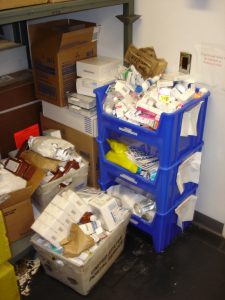 Once upon a time, EPA attempted to make pharmaceutical waste a universal waste. This proposal and draft rule (which attempted to make management of pharmaceutical waste less onerous for healthcare facilities) died on the vine and will likely never be finalized by EPA. Just in time for the holidays, however, EPA changed its strategy and published the final “Management Standards for Hazardous Waste Pharmaceuticals and Amendment to the P075 Listing for Nicotine” on December 11, 2018. According to the EPA press release, “This final rule establishes cost-saving, streamlined standards for handling hazardous waste pharmaceuticals to better fit the operations of the healthcare sector while maintaining protection of human health and the environment.”
Once upon a time, EPA attempted to make pharmaceutical waste a universal waste. This proposal and draft rule (which attempted to make management of pharmaceutical waste less onerous for healthcare facilities) died on the vine and will likely never be finalized by EPA. Just in time for the holidays, however, EPA changed its strategy and published the final “Management Standards for Hazardous Waste Pharmaceuticals and Amendment to the P075 Listing for Nicotine” on December 11, 2018. According to the EPA press release, “This final rule establishes cost-saving, streamlined standards for handling hazardous waste pharmaceuticals to better fit the operations of the healthcare sector while maintaining protection of human health and the environment.”
If you represent a healthcare facility, you already understand why pharmaceutical waste management is high on your environmental liabilities list. There are approximately 30 commercial chemical products listed on the RCRA P and U hazardous waste lists that have pharmaceutical uses. Generation of even a small amount of P-listed waste (1 kg or 2.2 lbs) requires operation as a large quantity generator. Additionally, the use of popular “reverse distributors” (companies that take unused pharmaceuticals back to manufacturers for credit) has been murky at best. Ask many nurses what they do with unused or dropped medication, and the answer is frequently to flush it or put it in the sharps container (we know, we have asked many). Pharmaceutical technicians are charged with rotating stock, removing expired medications, and then figuring out what to do with expired medication. It can all be a lot for a healthcare facility to handle, especially with rules that were never written with the healthcare facilities in mind.
EPA is seeking with these new management standards to correct some of that confusion. Some facts about the new management standards:
- The final standards apply to healthcare facilities and reverse distributors that generate and manage hazardous waste pharmaceuticals. This rule also applies to anyone who generates or manages discarded FDA-approved over-the-counter nicotine replacement therapies (i.e., patches, gums and lozenges).
- The final standards do not apply to pharmaceutical manufacturers (unless they act as reverse distributors), production facilities or other generators of hazardous waste pharmaceuticals.
- Under the final standards, generators of hazardous pharmaceutical wastes will manage their hazardous waste pharmaceuticals under subpart P of part 266 in title 40 of the Code of Federal Regulations (CFR), instead of the standard RCRA generator regulations found in part 262.
- The final standards are tailored to how reverse distributors operate and will replace the standard generator regulations for the accumulation and management of hazardous waste pharmaceuticals at reverse distributors.
- The final standards exempt FDA-approved over-the-counter nicotine replacement therapies from regulation as a RCRA hazardous waste.
- This final rule will be effective at the federal level six months after the rule is published in the Federal Register. Authorized states are required to adopt this final rule and to modify their RCRA programs in order to retain their authorized status because this rule is more stringent than current RCRA generator regulations.
View a summary of the final rule.
View a pre-publication version of the final rule.
EPA is holding three webinars to discuss the contents of the final rule (they are all the same, just on different days). The webinars, which are free and open to the public, are scheduled for February 14, March 4 and March 14. Visit the EPA website to register to attend one of the webinars.
 Julia Norris is a California-based Certified Hazardous Material Manager, Certified Professional Environmental Auditor, and senior environmental protection specialist with 19 years of professional experience. She has expertise in a wide range of technical areas, including regulatory compliance auditing, air emissions inventories, SPCC Plans, drinking water sampling plans, SWPPPs, wastewater pretreatment programs, solid waste characterization studies, pollution prevention planning, hazardous material/waste management, storage tank management, and NEPA analysis.
Julia Norris is a California-based Certified Hazardous Material Manager, Certified Professional Environmental Auditor, and senior environmental protection specialist with 19 years of professional experience. She has expertise in a wide range of technical areas, including regulatory compliance auditing, air emissions inventories, SPCC Plans, drinking water sampling plans, SWPPPs, wastewater pretreatment programs, solid waste characterization studies, pollution prevention planning, hazardous material/waste management, storage tank management, and NEPA analysis.